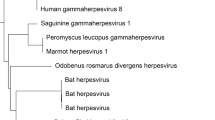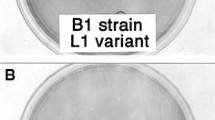Abstract
The herpes simplex type 1 biochemically transformed human cell line, HB-1, was fused with thymidine kinase deficient rodent cells, and 18 hybrids were isolated using the HAT-ouabain selection system. The selected enzyme, viral thymidine kinase, was present in all 18 hybrids. In 16 of 18 hybrids the viral gene for thymidine kinase cosegregated with the human gene for adenylate kinase-1 (AK-1). Thirty-six bromodeoxyuridine (BrdUrd) resistant sublines were isolated from the 16 human AK-1 positive hybrids. Each BrdUrd-resistant subline was examined for the presence of the viral TK gene by back-selection in HAT medium, and for human AK-1. In all 36 BrdUrd-resistant sublines the viral TK gene cosegregated with the human AK-1 gene. These results indicate that the transforming viral DNA fragment was associated with a specific human chromosomal region in HB-1 cells.
Similar content being viewed by others
References
Adams, A. (1973). Concentration of Epstein-Barr virus from cell culture fluids with polyethylene glycol. Gen. Virol. 20391.
Aiello, L., Guitfoyle, R., Huebner, K., and Weinmann, R. (1979). Adenovirus 5 DNA sequences present in RNA sequences transcribed in transformed human embryo kidney cells (HEK-Ad-5 or 293). J. Virol. 94460.
Bachetti, S., and Graham, F. L. (1977). Transfer of the gene for thymidine kinase to pyrimidine kinase-deficient human cells by purified herpes simplex viral DNA. Pro. Nat. Acad. Sci. 741590.
Biegeleisen, K., and Rush, M. G. (1976). Association of herpes simplex virus type 1 DNA with host chromosomal DNA during productive infection. Virology 69246.
Cremer, K., Bodemer, M., and Summers, W. C. (1978). Characterization of the mRNA for herpes simplex virus thymidine kinase by cell-free synthesis of active enzyme. Nucleic Acids Res. 52333.
Croce, C. M. (1977). Assignment of the integration site for simian virus 40 to chromosome 17 in GM54VA, a human cell line transformed by simian virus 40. Proc. Natl. Acad. Sci. 74305.
Croce, C. M., Girardi, A. J., and Koprowski, H. (1973). Assignment of the T-antigen gene of simian virus 40 to human chromosome C-7. Proc. Natl. Acad. Sci. 703617.
Davidson, R. L., and Gerald, P. S. (1976). Improved techniques for the induction of mammalian cell hybridization by polyethylene glycol. Somat. Cell Genet. 2165.
Davidson, R. L., Adelstein, S. J., and Oxman, M. M. (1973). Herpes simplex virus as a source of thymidine kinase for thymidine kinase-deficient mouse cells: Suppression and reactivation of the viral enzyme. Proc. Natl. Acad. Sci. 701912.
Davis, D. B., and Kingsbury, D. T. (1976). Quantitation of the viral DNA present in cells transformed by UV-irradiated herpes simplex virus. J. Virol. 17788.
Davis, D. B., Munyon, W., Buchsbaum, R. and Chawda, R. (1974). Virus type-specific thymidine kinase in cells biochemically transformed by herpes simplex virus types 1 and 2. J. Virol. 13140.
Donner, L., Dubbs, D. R., and Kit, S. (1977). Chromosomal site(s) of integration of herpes simplex virus type 2 thymidine kinase gene in biochemically transformed human cells. Int. J. Cancer 20256.
Elsevier, S. M., Kucherlapati, R. S., Nichols, G. A., Creagen, R. P., Giles, R. E., Ruddle, F. H., Willecke, K., and McDougall, J. K. (1974). Assignment of the gene for galactokinase to human chromosome 17 and its regional localization to band q 21–22. Nature 251633.
Franke, U. (1976). The human gene for β-glucuronidase is on chromosome 7. Am. J. Hum. Genet. 28357.
Harris, H., and Hopkinson, D. A. (1976). Handbook of Enzyme Electrophoresis in Human Genetics North-Holland, Amsterdam.
Humphrey, R. M., and Hsu, T. C. (1965). Further studies on biological properties of mammalian cell lines resistant to 5-bromodeoxyuridine. Tex. Rep. Biol. Med. 23321.
Jamieson, A. T., and Subak-Sharpe, J. H. (1974). Biochemical studies on the herpes simplex virus-specified deoxypyrimidine kinase activity. J. Gen. Virol. 24481.
Kit, S., Dubbs, D. R., Pierkarski, L. J., and Hsu, T. C. (1963). Delection of thymidine kinase activity from L cells resistant to bromodeoxyuridine. Exp. Cell Res. 31297.
Kit, S., Dubbs, D. R., and Frearson, P. M. (1966). HeLa cells resistant to bromodeoxyuridine and deficient in thymidine kinase activity. Int. J. Cancer 119.
Kit, S., Leung, W-C., Jorgenson, G. N., Trkula, D., and Dubbs, D. R. (1974). Thymidine kinase isozymes of normal and virus infected cells. Cold Spring Harbor Symp. Quant. Biol. 39703.
Kraiselburd, E., Gage, L. P., and Weisbach, A. (1975). Presence of herpes simplex virus DNA fragment in an L-cell clone obtained after infection with irradiated herpes simplex virus. J. Mol. Biol. 97533.
Kucherlapati, R., Huang, S. P., Shimzer, N., McDougall, J. K., and Botchan, M. R. (1978). Another chromosomal assignment for a simian virus 40 integration site in human cells. Proc. Natl. Acad. Sci. 754460.
Littlefield, J. W. (1965). Studies on thymidine kinase in cultured mouse fibroblasts. Biochim. Biophys. Acta 9514.
Maitland, N. J., and McDougall, J. K. (1977). Biochemical transformations of mouse cells by fragments of herpes simplex virus DNA. Cell 11233.
McKinlay, M. A., Wilson, D. E., Harrison, B., and Povey, S. (1980). Association of herpes simplex thymidine kinase gene with chromosome 18 in transformed human cells. J. Natl. Cancer Inst. 64241.
McKusick, V. A., and Ruddle, F. H. (1977). The status of the gene map of human chromosomes. Science 196390.
Miller, O. J., Miller, D. A., Allerdice, P. W., Dev, V. G., Grewal, M. S. (1971). Quinacrine fluorescent karyotypes of human diploid and heteroploid cell lines. Cytogenetics 10338.
Munyon, W., Kraiselburd, E., Davis, D., and Mann, J. (1971). Transfer of thymidine kinase to thymidine kinaseless cells by infection with ultraviolet-irradiated herpes simplex virus. J. Virol. 7813.
Munyon, W., Buchsbaum, R., Paoletti, E., Mann, J., Kraiselburd, E., and Davis, D. (1972). Electrophoresis of thymidine kinase activity synthesized by cells transformed by herpes simplex virus. Virology 49683.
Nonoyama, M., and Pagano, J. S. (1973). Homology between Epstein-Barr virus DNA and viral DNA from Burkitt's lymphoma and nasopharyngeal carcinoma determined by DNA-DNA reassociation kinetics. Nature 24244.
Nonoyama, M., Huang, C. H., Pagano, J. S., Klein, G. and Sigh, S. (1973). DNA of Epstein-Barr virus detected in tissue of Burkitt's lymphoma and nasopharyngeal carcinoma. Proc. Nat. Acad. Sci. 703265.
Ogino, T., and Rapp, F. (1971). Differences in thermal stability of deoxythimidine kinase activity in extracts from cells infected with herpes simplex virus type 1 or type 2. Virology 46953.
Paul, B., Porter, I. H., and Benedict, W. F. (1973). Giemsa banding in an established line of a human malignant menengioma. Hum. Genet. 18185.
Pellicer, A., Wigler, M., Axel, R., and Silverstein, S. (1978). The transfer and stable integration of the HSV thymidine kinase gene into mouse cells. Cell 14133.
Sharp, P. A., Petterson, V., and Sanbrook, J. (1974). Viral DNA in transformed cells. I. A study of the sequences of adenovirus 2 DNA in a line of transformed rat cells using specific fragments of the viral genome. J. Mol. Biol. 86709.
Shows, T. B., May, J., and Haley, L. (1972). Human-mouse cell hybrids: A suggestion of structural mutation for dipeptidase-2 deficiency in mouse cells. Science 17858.
Smiley, J. R., Steege, D. A., Juricek, D. K., Summers, W. P., and Ruddle, F. H. (1978). A herpes simplex virus 1 integration site in the mouse genome defined by somatic cell genetic analysis. Cell 15455.
Sugden, B., Summers, W. C., and Klein, G. (1976). Nucleic acid rematuration and restriction endonuclease cleavage analysis show that the DNAs of a transforming and non-transforming strain of Epstein-Barr virus share approximately 90% of their nucleotide sequences. J. Virol. 18765.
Swallow, D. M., Solomon, E., and Pajunen, L. (1977). Immunochemical analysis of the N-acetyl hexosaminidases in human-mouse hybrids made using a double selective system. Cytogenet. Cell Genet. 18136.
Thouless, M. E., and Wildy, P. (1975). Deoxypyrimidine kinases of herpes simplex viruses 1 and 2: Comparison of serological and structural properties. J. Gen. Virol. 26159.
Thouless, M. E., Chadha, K. C., and Munyon, W. H. (1976). Serological specificity of thymidine kinase activity in herpes simplex virus-transformed cells. Virology 69350.
Wigler, M., Silverstein, S., Lee, L., Pellicer, A., Cheng, Y., and Axel, R. (1977). Transfer of purified herpes virus thymidine kinase gene to cultured mouse cells. Cell 11223.
Wigler, M., Pellicer A., Silverstein, S. Axel, R., Urlaub, G., and Chasin, L. (1979). DNA-mediated transfer of the adenine phosphoribosyl transferase locus into mammalian cells. Proc. Natl. Acad. Sci. 761373.
Willicke, K., Reber, T., Kucherlapati, R. S., and Ruddle, F. H. (1977). Human mitochondrial thymidine kinase is coded for by a gene on chromosome 16 of the nucleus. Somat. Cell Genet. 3237.
Wilson, D. E., Povey, S., and Harris, H. (1976). Adenylate kinases in man: Evidence for a third locus. Ann. Hum. Genet. 39305.
Author information
Authors and Affiliations
Additional information
This investigation was supported by Grant CA 16550, awarded by the National Cancer Institute, and BRSG Grants RR07104-10 and RR07104-9, awarded by the Biomedical Research Support Grant Program, Division of Research Resources, DHEW.
Rights and permissions
About this article
Cite this article
Wilson, D.E., McKinlay, M.A., Staczek, J. et al. Association of the herpes simplex-1 viral gene for thymidine kinase with the human gene for adenylate kinase-1 in biochemically transformed cells. Biochem Genet 18, 981–1001 (1980). https://doi.org/10.1007/BF00500130
Received:
Revised:
Issue Date:
DOI: https://doi.org/10.1007/BF00500130




